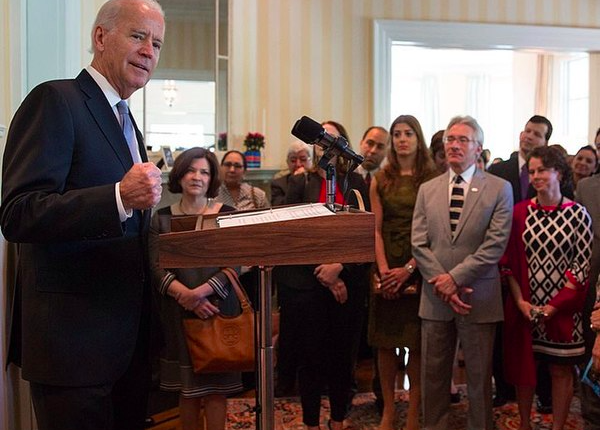Joe Biden: The Promised Immigration Saviour?

President Joe Biden has recently fallen under fire after it was revealed that thousands of migrant minors are being held at the southern border for quarantine purposes. Many who have yet to forget former President Trump’s “kids in cages” controversy have drawn parallels between these instances. While Biden pledges the border shelters ‘won’t stay open very long,’ there remain signs of skepticism across the progressive side of the democratic party and in immigrant communities.
After four years under Donald Trump’s “America-first” policies, many Americans are hopeful that President Biden will deliver a much-needed immigration overhaul. Yet, early action would indicate that this is becoming less likely. On the campaign trail, he promised a path to citizenship for undocumented workers through the now-proposed Citizenship Act. But with a divided Senate, the Biden administration will face an uphill battle to gain the support of Republicans and critical moderate Democrats. By looking at the Obama administration’s challenges, it is understandable that good intentions can wither when faced with political reality. Given the high percentage of former Obama team members that comprise “team Biden,” will the new administration follow a similar path? While many Americans remain hopeful that the border shelter situation is not an early indicator that President Biden will fall into the same traps that turn good intentions into watered-down policy, only time will tell.

Past presidents’ policy
Much of the world looks fondly at President Obama’s tenure, but one area of disappointment relates to his administration’s record on immigrant rights. During the 2012 reelection campaign, the President came under criticism from advocacy groups declaring him the “deporter in chief,” as his administration had seen deportation numbers rise compared to former President Bush. One policy that haunts the Obama administration’s legacy is the construction of the well-publicized detention centers that house the actual cages used to hold children during the Trump administration. Yet, Obama also pioneered many positive immigration changes. President Obama made considerable headway in immigration reform through executive orders to provide protected status for undocumented people and to establish Deferred Action for Childhood Arrivals (DACA). Given both the positive and negative aspects of Obama’s legacy on immigration policy, it remains to be seen how immigration policy will change under the Biden administration. Hopefully, he will embrace the positive aspect of the Obama-era policies and have more success delivering permanent change.
In addition to owning the full legacy of the Obama-era immigration policy, President Biden must also manage the transition from the Trump administration’s extreme measures. While Trump’s focus was on eliminating illegal immigration, he also cut legal immigration in half during his presidency. High-skilled workers were denied visas, and asylum seekers were refused support. Trump’s most pronounced and controversial action was the 2018 family separation policy, which divided immigrants waiting to be processed at the border and put them into fenced detention centers. Trump eventually signed Executive Order 13841 in June of 2018, which suspended the policy of the separation and detention of families, but even three years later, children are still searching for their parents. Dealing with the continued outrage associated with these policies domestically and internationally is something that President Biden will need to address when defining the future of immigration.

Biden’s conflicting strategies
The Biden administration’s principle strategy includes the extensive Citizenship Act, which would lay out a plan for an estimated 11 million undocumented migrants to become legal citizens. Biden estimates a timeline of eight years for immigrants to gain citizenship. Furthermore, the bill establishes legal immigration reform by providing more funding to judges and increased legal counsel. If passed, the bill would provide more extensive funding for counselling children and other vulnerable individuals and extend the one-year filing limit for asylum. The bill would also replace the term “alien” on laws with “noncitizen.” This terminology change is a win because it removes the dehumanizing context from legal documents. If passed, the Citizenship Act will benefit millions of immigrants.
Yet, for all its positives, the Citizenship Act has an uphill climb in Congress. While the Democrats hold a majority in the house, the split Senate will require the support of 10 Republicans to get the 60 vote majority to pass the measure. Because of government in-fighting, this will be no easy feat, and the bill could easily die on the Senate floor.
Despite the commitment to this bill and talks of immigration transformation as critical to his presidency, Biden has also experienced some early missteps. His modern “kids in cages“ controversy will not be easily forgotten as children have been detained in Texas for COVID-19 quarantine. Furthermore, Biden has decided to keep Trump’s Title 42 in place. This public health code allowed Trump to use the pandemic’s restrictions to limit immigrant border passings. As a president who promised that he would reverse Trump’s policies, Biden may now be forced to strategically balance and choose which guidelines fit his ever-growing priorities.
President Biden was handed a mixed bag of immigration policies during his transition into the White House. He was tasked with undoing Trump-era policies while also taking the best elements of Obama’s plans to move the system slowly in the right direction. There are additional government challenges from both sides of the political spectrum. Republicans believe that Biden’s campaign promises would be taking immigration reform too far. In contrast, Progressive Democrats do not believe Biden will go far enough to deliver a complete overhaul of the system. Since Biden’s proposals will not prove satisfactory to either side, he runs the risk of remaining stuck in political stagnation.

Looking forward, President Biden faces many challenges to overhaul American immigration policy as promised during the 2020 campaign. These challenges stem from his predecessors’ immigration policies as well as health and economic priorities to combat the pandemic. Actions related to holding minors at the border appear to conflict with his stated intentions, thus offering a confusing message to the American people. To demonstrate his vision, he will need to move immigration policy slowly in the right direction by working to repeal Trump programs. He will also have to look back on his vice presidency and correct errors in Obama’s implementation of proposed immigration policy changes. The Citizenship Act would change the lives of millions but will face many challenges within the US Senate. Crossing the aisle may result in a less transformative bill, but it might be the only way for Biden’s ideas to be passed.
While President Biden is only in the early days of his administration, and sweeping systemic changes will not happen on day one, he must work with expediency. Although his term is four years and may seem like a long runway, the midterm elections are less than two years away. Even if he cannot produce an immigration overhaul, Biden has the opportunity to move the country in the right direction, setting up a future president to further deliver on his promise.
Featured image: “last day at the No Borders Camp – 24” by Steev Hise is licensed under CC BY-NC-SA 2.0
Edited by Jessica Maloney
